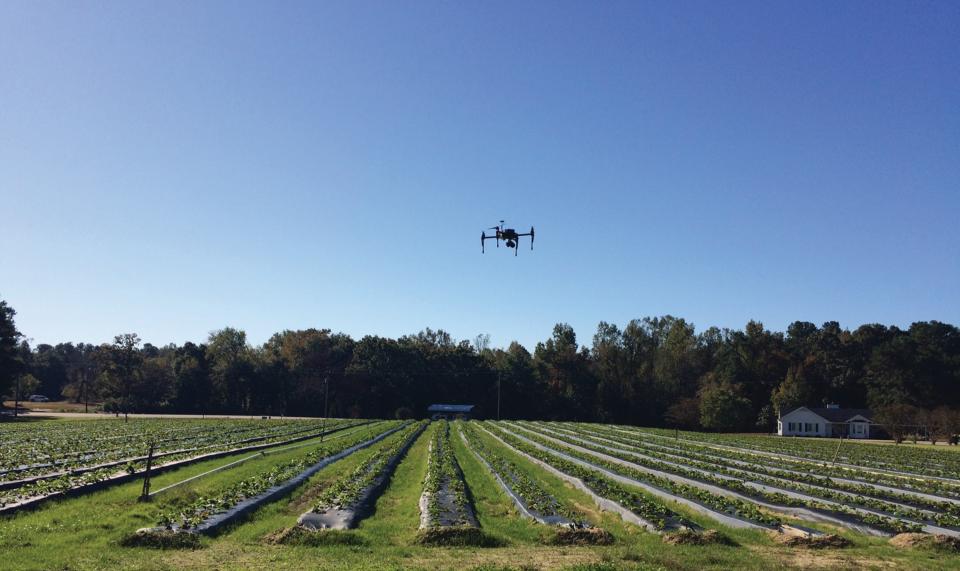How High-Flying Technology Can Be a Game-Changer for Berries

As this drone flies over a field of strawberries, it’s providing the grower with valuable scouting information at a much faster pace than the standard boots-on-the-ground view. (Photo: PrecisionHawk)
Imagine waking up to find that Mother Nature cursed your crop with monsoon-like rains. Despite some last-minute weather reports, there was only so much you could do before the devastating flood.
That’s precisely what happened to a North Carolina tobacco farmer, who dealt with severe washout problems following a similar weather incident. The damage was so bad, the farmer couldn’t drive a truck into the affected areas. This essentially left him blind, unable to access the damage. Fortunately, there was a technological solution.
“He could put a drone up before he could drive out,” explains Bobby Vick, solutions engineer at commercial drone-and-data company PrecisionHawk. “This him to make a decision about what was salvageable, the new yield potential for the field, and how and where to target any crop inputs for the remainder of the season.”
An Obvious Benefit
Drones and unmanned aerial vehicles are influencing the agriculture sector more than ever before. PrecisionHawk has been there since the beginning, first building the unmanned aerial vehicles (UAVs) before focusing on the software and data collection components. The company’s bread and butter has always been the agricultural market. Although it primarily worked with farmers of agronomic crops like tobacco, soybeans, and corn, the fruit and vegetable farmers eventually came calling.
Financially, this makes perfect sense. Since high-value and high-input specialty crops force growers to spend more to make more, Vick explains, producers massively increase their profits if they can increase their overall productivity and efficiency.
“Drones have the obvious benefit of enabling farmers to see their crops in a way they couldn’t traditionally, faster than ever before,” Vick says. “The drone can scan each square inch of the field, and the grower can have the imagery back in a couple of hours. It wouldn’t be feasible to do that by hand.”
Application in Berry Production
For strawberry producers, drones can be used to identify disease pressures, monitor yields, and determine where the crop is stressed. They also can be deployed with a thermal sensor to collect data on soil moisture status, detect drip irrigation leaks or other glitches, and much more.
“Drones have the potential to detect a problem before a farm worker would be able to see it with his or her eyes,” Vick says. “Most strawberry crops are hand-picked, but the drone is another mechanism to get more focused and localized info across the strawberry fields.
“Not all fields are uniform, but growers don’t have an easy way of quantifying that,” he continues. “Drone technology means growers have a better idea of what’s going on around the farm.”
Prepare for Takeoff
It’s tempting to see the possibilities and want to build a fleet right away; however, the process isn’t as simple as purchasing a few UAVs. Growers need to prepare for the initial takeoff. Drones come in many shapes and sizes, and each model offers unique advantages. For strawberry growers who haven’t used drones before, Vick recommends starting small.
“It would depend on the application the grower has in mind, but for $1,500, he or she can get an entry-level but very productive drone,” he says. “This price point gives growers access to high-resolution images and access to plant health data. When you’re just starting out, it’s not important to purchase the biggest and most expensive models.”
He also recommends growers start with a multirotor drone. This is the preferred model because it’s versatile, user-friendly, and can land more easily in smaller spaces. The other option, fixed-winged drones, fly longer distances and boast longer flight times. But the multirotor models’ precision is hard to beat. Vick says that in most cases, the multirotor will be the best choice for specialty crops like strawberries.
Even after growers purchase a drone, there’s still plenty to be done before the first flight. Not just anyone can deploy and fly a drone in a commercial setting. Someone on the farm will need to take and pass the test to become a certified drone operator.
The license requires some preparation to pass a 60-question multiple choice test, and only licensed operators can commercially fly the drones. For large farms, this might mean requiring each field or farm manager to become licensed. It also helps to have multiple drones so that everyone can deploy one quickly, without waiting for another part of the operation to finish using the one shared machine.
Interpreting is Important Part
While the machinery and operator components are important, the devil is in capturing and understanding the data. As Vick puts it, “I always tell people that flying the drone is the easy part.”
Growers also have the option to hire an outside drone service to take care of the details. The benefit is that not only will someone fly the drones, that person also will be able to understand the subsequent data.
“You want the information to be actionable,” says Vick. “This requires someone to be able to interpret the data and analytics after they are collected.”
The value is in being able to quickly make corrections to crops based on the information. All the data and imagery in the world are useless unless they can be used to produce better strawberries, faster.
While drones are still relatively new to the specialty crop industry, their capabilities will continue to improve. Right now, for example, the sensors and analytics offer generic information about plant health and stresses. Vick foresees a future where the data will become increasingly targeted.
“There will eventually be a strawberry crop sensor that’s different from a blueberry crop sensor, and we will be able to identify disease A versus disease B,” he says. “As we continue to collect data, we’ll be able to apply artificial intelligence and machine learning to those data sets to help growers make the best, most informed decisions about their crop.”Bobby Vick of PrecisionHawk says.










